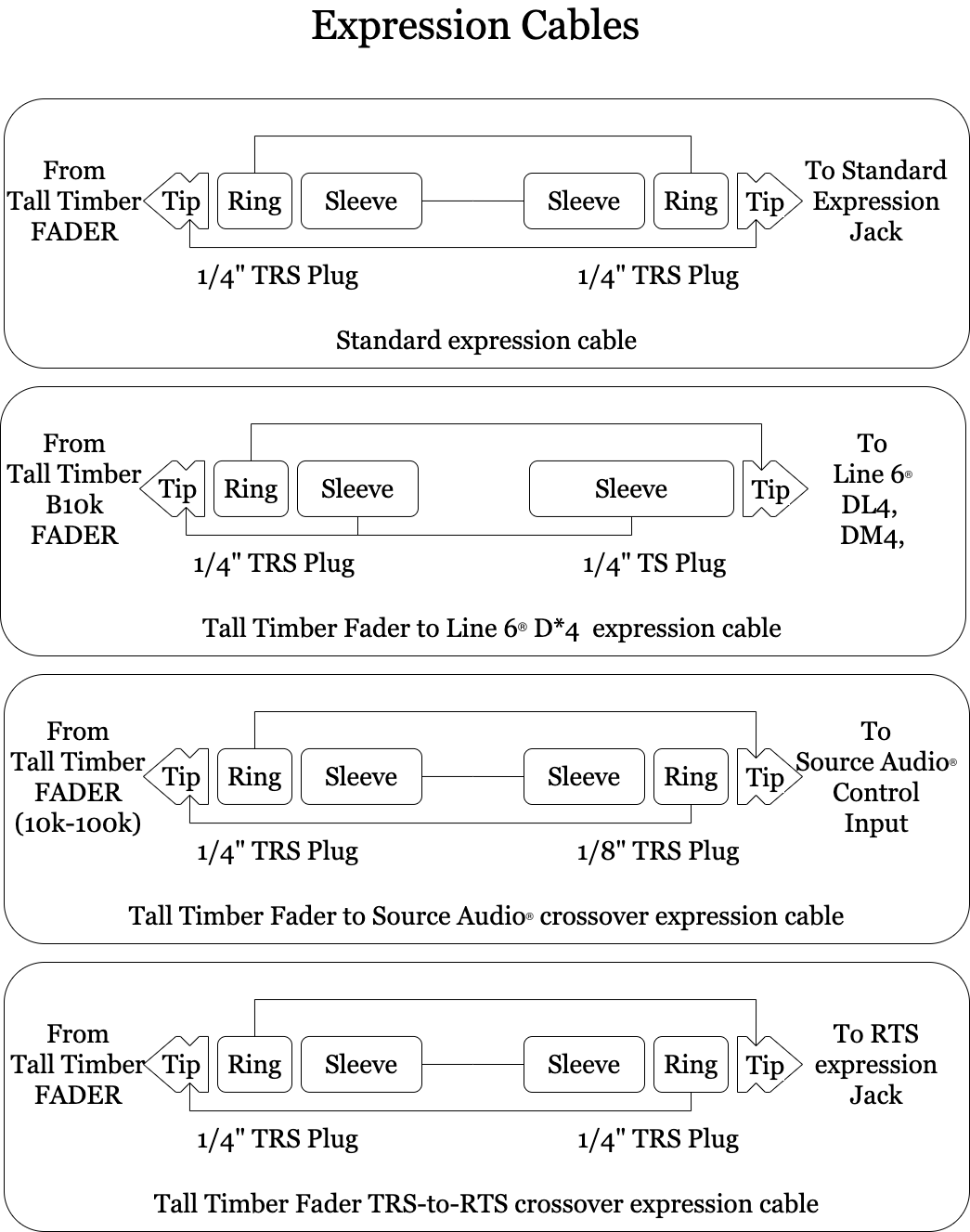Taper? I hardly know her!
Explanation of potentiometer taper options for expression and volume controls, including Tall Timber’s “Quasi-linear” taper.
Linear? Audio? Log? Antilog? What does it all mean and how do I choose the right potentiometer resistance taper for my application?
Potentiometer Model
First, let’s look at a model for a potentiometer. We can model a potentiometer as two resistors in series, with access to all three nodes. The node joining the two resistors is the “wiper”.
As the wiper position is changed (knob rotated or fader moved) the values of Rtop and Rbot change.
Let’s assume a signal is input at the top of the resistor chain and the output is taken at the wiper, with the bottom of the chain grounded. The output can then be calculated as a ratio of the resistance below the wiper to the total resistance of the potentiometer.
Expanding this simple model a little, we can model the pot as a large chain of resistances with the wiper able to slide to any node within the chain.
This model is the same no matter what “taper” of potentiometer. The relative resistances of the resistors in the chain is what defines the taper of the potentiometer.
The two most common potentiometer tapers are Linear and Log. Log taper is also sometimes called “Audio” taper.
A linear taper results when all of the resistances in the model are equal to one another. Audio/log tapers have lower resistance towards the counter-clockwise position.
In reality, potentiometers are not built of individual resistors like this simplified model, of course. The pot is typically a stripe of resistive material over which the wiper travels, and the manufacturer controls the resistance of areas of the stripe by adjusting material properties or geometry of the stripe itself. The result is the same - the output of the pot as a percentage of input can be altered by changing the resistance in different areas of the pot.
Taper Types
There are a few different potentiometer tapers typically available.
Linear Taper - Often designated as a “B” taper, this is the most common type. The output, as a percentage of input, matches the wiper position as a percentage of fully clockwise. At 10% clockwise the output is 10% of the input. At 50%, it’s 50%. At 80% it’s 80%….
Log Taper - This is often called “Audio Taper” or “A” taper. Increasing the wiper position near the bottom (counter-clockwise) position of the pot has a small effect on the output, while moving the wiper the same amount near the top (clockwise) position has a greater effect. You can see this in the graph above.
Antilog Taper - Sometimes called “reverse” taper, these are less common than linear and log. It’s kind of the opposite of log taper, with the output being more sensitive at the bottom of the travel than at the top.
So that’s it, right? A log taper is a log taper, no matter which manufacturer makes it, right? Well, no, there are some subtle differences between manufacturers and some manufacturers offer multiple variations. Take Alps for example:
In addition to the linear (B) taper, they offer at least three log tapers (K, A, and D), and none of these are identical to the tapers offered by Bourns, as another example:
OK, OK, That’s a lot. Help me choose!
So, which taper should you choose?
Well, if you’re here at Tall Timber, you’re probably looking for an expression or volume control for your guitar or synth rig, so let’s just focus on that.
Generally, but not always, volume controls use log/audio taper pots. Why? Human perception of loudness is logarithmically related to sound pressure. So if you’re adjusting output volume, using a log pot offers a response best matched to human hearing. Do you have to use a log pot? Absolutely not. I’m not the boss of you! You can use linear for volume applications, you’ll just have less fine-control of the low-volume range compared to a log pot.
What about expression pedal applications? Should you use linear or audio taper for expression? First, make sure you are choosing the right resistance and topology. That’s an actual requirement and differs among pedal and synth manufacturers. Your gear manual may also recommend a linear taper. They generally do, and I do as well, but this is not a requirement. If you want finer expression of the lower range of whatever you’re expressing, feel free to use an audio taper. Want to go crazy with a reverse taper? Get a Fader DLX, rotate it 180 degrees and engage the “flip” switch!
What’s this “Quasi-Linear” taper you offer?
There are ways of modifying the effective output taper of potentiometers by adding external resistors across the 3 pot terminals.
To linearize an audio taper, we attach a resistance from input to wiper (output) with a value of 20% of the pot resistance. In most cases we offer this as a switchable option. For instance on our Fader DLX.
Audio Taper Pot, Linearized with External Resistor
When this resistor is switched in, it alters the taper as shown in the graph below. The blue line represents the stock audio taper of the Bourns slide pot. The orange line shows the altered “quasi-linear” taper presented when the Taper Option switch is engaged.
Be aware that these linearizing resistors do effect the input resistance of the potentiometer. The input resistance will vary with wiper position, as shown below for a 100kOhm potentiometer in Quasi-linear mode. For this reason, Quasi-linear controllers may not be appropriate for devices with high output impedance.
Most of our expression and volume controllers have options (sometimes hidden) to alter the taper. If you’d like a particular non-standard taper, just let us know and we can cook something up for you, or guide you on how to do it yourself, if you’re of that breed!
Thanks for reading, control freaks! We like you!
Using an Expression Controller as a Volume Control
We are frequently asked “You say your Fader and Fader DLX are both expression and volume controllers. I only see 1 jack. How can I use it as a volume control?”
It’s a good question. Here’s the answer.
To use the Fader and Fader DLX as a volume control, you need an “insert cable”. An insert cable has a Tip-Ring-Sleeve (TRS) jack on one end and 2 Tip-Sleeve (TS) jacks on the other end.
Connect the TRS end of the cable to the Fader or Fader DLX and then connect the TS jack marked “Ring” or “RNG” to the output of the device you want to control, and connect the TS jack marked “Tip” to the input of the next device.
That’s it. Now your Fader is adjusting the volume between your other two devices.
Insert cables are available from a number of vendor and are pretty easy to make yourself, if you’re so inclined. Here are some insert cables available from Sweetwater. It’s not an exhaustive list. My current favorites are from Rockboard/Warwick.
Have more questions? Please contact us!
Choosing the Right Fader for Expression
Some simple guidance
Not all expression pedals and faders work with all pedals. Here’s some quick guidance on how to select the right fader.
There are 2 variables that you need to consider when matching an expression controller to your pedal:
Topology - in all of the configurations the sleeve of the jack is connected to the “bottom” of the potentiometer:
TRS - the most common configuration, with the ring of the jack connected to the top of the potentiometer, and tip connected to the wiper of the pot,
RTS - similar to the TRS connection, but with the tip and ring connections swapped, and
TS - a 2-conductor configuration where the wiper and top of the pot are both connected to the tip of the jack
Resistance - each vendor suggests a resistance value or range of resistance values that work with their pedals.
So, both topology and resistance need to be considered when selecting the right expression Fader for your pedal. But how do you figure out what you need?
1) Ask me, and I’ll happily go figure it out for you, or
2) Check with the vendor of your pedal and see what they recommend, or
3) Check this useful reference.
Fader and Fader DLX are offered in a range of resistances, and natively support the TRS topology. Other topologies can be supported with a simple custom cable. If you’re in need of such a cable to match a Tall Timber Fader to your pedal, please let me know and I’ll help you get it sorted out!
If you’re keen on making up a cable for yourself, here are some common (and uncommon!) cable diagrams. Have at it!
















